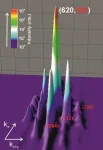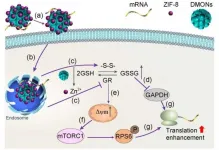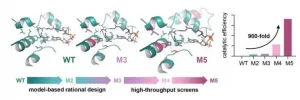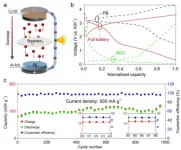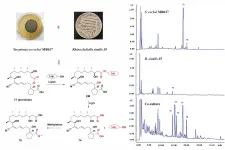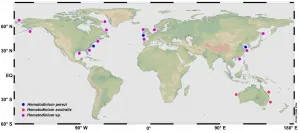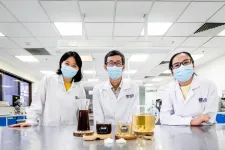Tasmanian tiger pups found to be extraordinarily similar to wolf pups
Tasmanian tigers start to look like dogs in the pouch
2021-01-11
(Press-News.org) Micro-CT scanning and digital reconstructions have been used to compare the skulls of the Tasmanian tiger (thylacine) and wolf across their early development and into adulthood, establishing that not only did the thylacine resemble the wolf as adults, but also as newborns and juveniles.
"Remarkably, the Tasmanian tiger pups were more similar to wolf pups than to other closely related marsupials," Professor Andrew Pask from the University of Melbourne said.
The collaborative study with Flinders University and Museums Victoria complement earlier findings that thylacine and wolf have evolved similar instructions in their genome, which influence cranial stem cells during development.
While scientists have worked out that different animals evolve to look the same because they occupy similar places in the ecosystem, they have yet to explain how animals evolve to become convergent, particularly the forces driving their early development. The study provides significant new insights into how animals develop to look a certain way and then when in development these things happen.
Through collaborations with Australian museums and the Museum of the North in Alaska, USA, the team loaned thylacine and wolf skulls of different ages, stages and sizes, from newborns through to fully grown adults. They then applied micro-CT scanning to the skulls to generate digital models which could be compared to determine when during development similarities arose between the thylacine and wolf.
After reconstructing the early pouch development of the thylacine, lead author Dr Axel Newton focused on the question of when during development the Tasmanian tiger establish its dog-like skull shape.
"We know that the thylacine and wolf look similar as adults, but we don't know when they started to exhibit their remarkable similarities during development," he said.
Micro-CT scanning is a technique similar to a medical CAT scan, allowing researchers to generate high-resolution, digital reconstructions of complex shapes such as skulls and bones. From here they were able to establish that not only did the Tasmanian tiger resemble the wolf as adults but were very similar as newborns and juveniles.
Dr Vera Weisbecker, from Flinders University, said all marsupials - including the thylacine - are born with unusually well-developed jaws relative to the rest of the head.
"Scientists think that this reduces the potential of marsupials to evolve some extreme skull shapes. However, it clearly did not prevent the evolution of the thylacine's unusual wolf-like skull!"
The University of Melbourne's Dr Christy Hipsley, who specialises in CT, said the research shows how 3D imaging can reveal hidden diversity in nature.
"By comparing entire growth series from newborns to adults, we were able to visualise tiny differences in development that pinpoint when and where in the skull adaptations to carnivory arise on a cellular level. That is only made possible through museum loans of preserved specimens, in this case from as far away as Alaska."
INFORMATION:
[Attachments] See images for this press release:
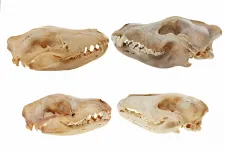
ELSE PRESS RELEASES FROM THIS DATE:
2021-01-11
Artificial intelligence and machine learning are already an integral part of our everyday lives online. For example, search engines such as Google use intelligent ranking algorithms and video streaming services such as Netflix use machine learning to personalize movie recommendations.
As the demands for AI online continue to grow, so does the need to speed up AI performance and find ways to reduce its energy consumption.
Now a University of Washington-led team has come up with a system that could help: an optical computing core prototype that uses phase-change material. This system is fast, energy efficient and capable of accelerating ...
2021-01-11
Topological materials are characterised by unique electronic and physical properties that are determined by the underlying topology of their electronic systems. Scientists from the Max Planck Institutes for Microstructure Physics (Halle) and for Chemical Physics of Solids (Dresden) have now discovered that (TaSe4)2I is the first material in which a charge density wave induces a phase transition between the semimetal to insulator state.
An international team of scientists at the Max Planck Institute for Microstructure Physics, Halle (Saale), the Max Planck Institute for Chemical Physics of Solids ...
2021-01-11
Delivery of genetic molecules such as mRNA into cells is vital with important applications such as vaccine development. Various agents have been developed for mRNA delivery. However, conventional mRNA nanocarriers mainly focus on their physical interaction with mRNA molecules, or protection / delivery of mRNA, such as adjusting physical properties of nanocarriers to control binding with mRNA or cellular uptake. Moreover, effective mRNA delivery in hard-to-transfect APCs remains a challenge. The hard-to-transfect nature in APCs is partly attributed to the suppressed mRNA translation associated with the intrinsic high intracellular glutathione (GSH) level. Thus, ...
2021-01-11
Photorespiration is a highly energy consuming process in plants that leads to the release of previously fixed CO2. Thus, engineering this metabolic process is a key approach for improvement of crop yield and for meeting the challenge of ever-rising CO2 levels in the atmosphere. Researchers led by Tobias Erb from the Max Planck Institute for Terrestrial Microbiology in Marburg, Germany, have now succeeded in engineering the TaCo pathway, a synthetic photorespiratory bypass. This new-to-nature metabolic connection opens up new possibilities of CO2 fixation ...
2021-01-11
With the rapid development of smart portable electronics and electric vehicles, the consumption of lithium resource will increase dramatically and the cost of lithium-ion batteries (LIBs) may increase significantly in the future. In addition, the shortage (0.0017 wt% in the earth's crust) and uneven crustal distribution of lithium also limit its further development and application. As potassium (2.7 wt% in the earth's crust) have properties similar to lithium and abundant reserves. Therefore, as an alternative to LIBs, potassium ion batteries (PIBs) have become the focus of research. Potassium (2.92 V vs. ...
2021-01-11
Scientists from the Max Planck Institute of Psychiatry, led by Nikolaos Koutsouleris, combined psychiatric assessments with machine-learning models that analyse clinical and biological data. Although psychiatrists make very accurate predictions about positive disease outcomes, they might underestimate the frequency of adverse cases that lead to relapses. The algorithmic pattern recognition helps physicians to better predict the course of disease.
The results of the study show that it is the combination of artificial and human intelligence that optimizes the prediction ...
2021-01-11
The spiky structure that erupts from the smooth surface of a ferrofluid when a magnet is brought close can be predicted more accurately than previously thought. KAUST researchers have shown that computational algorithms can calculate the ferrofluid's bristling response to a magnet by simulating only the liquid's surface layer.
Ferrofluids are liquid suspensions of iron-based particles that behave like a regular fluid, but once a magnet is present, the ferrofluid rapidly shape-shifts to form spikes that align with the magnetic field. Originally developed by NASA, ferrofluids have numerous uses ranging from advanced electronics to nanomedicine and have the potential for even broader use, if their magnetic responses could be predicted more accurately.
Dominik Michels and ...
2021-01-11
Co-culture: stimulate the metabolic potential and explore the molecular diversity of natural products from microorganisms
Announcing a new publication for Marine Life Science & Technology journal. In this review article the authors Xiao-Yue Peng, Jin-Tao Wu, Chang?Lun Shao, Zhi-Yong Li, Min Chen and Chang-Yun Wang from the Ocean University of China, Qingdao, China, Yangzhou University, Yangzhou, China, Qingdao National Laboratory for Marine Science and Technology, Qingdao, China and Shanghai Jiao Tong University, Shanghai, China consider the metabolic potential and molecular diversity of natural products from microorganisms.
Microbial secondary metabolites have long ...
2021-01-11
Announcing a new publication for Marine Life Science & Technology journal. In this review article the authors Caiwen Li, Meng Li and Qian Huang from Institute of Oceanology, Chinese Academy of Sciences, Qingdao, China consider the impact of the parasitic dinoflagellate Hematodinium on aquaculture of marine crustaceans in China.
Hematodinium is a type of parasitic dinoflagellate that infects marine crustaceans globally. The parasite lives mainly in the hemolymph or hemocoels of affected hosts, and results in mortalities due to malfunction or loss of functions of major organs.
In recent years, the parasite has developed into an emerging epidemic pathogen not only affecting wild populations of economically valuable marine crustaceans ...
2021-01-11
Good news for those who need a cuppa to start the day. Researchers from the National University of Singapore (NUS) have created new probiotic coffee and tea drinks that are packed with gut-friendly live probiotics.
Supervised by Associate Professor Liu Shao Quan from the Department of Food Science and Technology at the NUS Faculty of Science, the two doctoral students who worked on these two new beverages assert that their drinks have a great taste, and can be stored chilled or at room temperature for more than 14 weeks without compromising on their probiotic viability.
Traditional probiotic carriers like yoghurts and cultured milks are dairy-based products. The rise in veganism, along with common health issues like lactose intolerance, high ...
LAST 30 PRESS RELEASES:
[Press-News.org] Tasmanian tiger pups found to be extraordinarily similar to wolf pups
Tasmanian tigers start to look like dogs in the pouch

